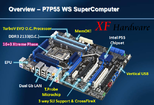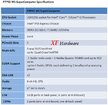Tuesday, August 18th 2009

ASUS Prepares First LGA-1156 Workstation Motherboard
ASUS, known for its single-socket workstation motherboards, is preparing the first enterprise-grade socket LGA-1156 motherboard. The ASUS P7P55 WS SuperComputer builds on the features of its socket LGA-1366 cousins, by offering as many as five PCI-Express 2.0 x16 slots, a massive 16+3 phase CPU VRM, support for DDR3-2133 by overclocking, and the latest multi-GPU standards support.
Based on the Intel P55 chipset, the P7P55 WS SuperComputer makes use of a PCI-E bridge chip that allows it to hold at least four PCI-E 2.0 x16 devices (electrical 4x PCI-E x8), with a PCI-E x16 electrically x4. Both 3-way SLI and 4-way CrossFireX are supported. Connectivity is care of two gigabit Ethernet controllers, 8 USB 2.0 ports on the rear-panel, and another six internal, Firewire, and 8-channel audio with digital IO ports and DTS support.
ASUS includes its own design enhancements, including XtremePhase VRM, TurboV EVO voltage management, and a probe microchip. It doesn't look like ASUS will add this to its first wave of motherboard launches that coincide with those of Intel's first LGA-1156 processors, but expect this to be out at least in October.
Source:
XFastest
Based on the Intel P55 chipset, the P7P55 WS SuperComputer makes use of a PCI-E bridge chip that allows it to hold at least four PCI-E 2.0 x16 devices (electrical 4x PCI-E x8), with a PCI-E x16 electrically x4. Both 3-way SLI and 4-way CrossFireX are supported. Connectivity is care of two gigabit Ethernet controllers, 8 USB 2.0 ports on the rear-panel, and another six internal, Firewire, and 8-channel audio with digital IO ports and DTS support.
ASUS includes its own design enhancements, including XtremePhase VRM, TurboV EVO voltage management, and a probe microchip. It doesn't look like ASUS will add this to its first wave of motherboard launches that coincide with those of Intel's first LGA-1156 processors, but expect this to be out at least in October.


12 Comments on ASUS Prepares First LGA-1156 Workstation Motherboard
I was planning on going i5, this board has all the features I'd want.
I just hope it OCs well.
OK, so there is a PCI-E bridge chip. But how does this work? Does it provide extra PCIe lanes through DMI (and is therefore higher latency), or does it just "share" all lanes across all PCIe expansions. If so, how many lanes can it run concurrently. And how does it allocate those lanes? Equally, or is it configurable in BIOS?
Interesting. But confusing.
Not to mention RAID cards and other such things that use x16 slots, this would be a great all-rounder of a motherboard!
nothing special here.
8x 4x 4x 4x at best
p55 uses the old DMI interface so you cannot provide more pcie lanes like you can on X58 that uses QPI.
believe it or not, QPI is far superior to DMI.
socket 1156 boards are not a whole lot more than a Nehalem cpu stuffed onto a p45 mobo. yes p55 works differently but there is still alot of drawbacks to DMI.
this is "mainstream" though so it does meet the target goal to provide something better than 775's performance at a moderate price compared to i7/x58 combo.
In theory, you could add extra PCIe lanes bridged to the DMI. Or you can "switch" multiple PCIe lanes over one PCIe lane. However they would NOT be fast, but would operate at a slower speed. OK, perhaps, for some devices, but certainly not for GPU or CUDA.
The "bridge chip" is essentially a "switch" that makes, e.g. one PCIe x4 lane slot, into two x4 lanes. Think of it in the same way as a switch on a gigabit network.
It means you CAN RUN 2 devices instead of 1. AND they will both get FULL bandwidth, so long as they dont want it AT THE SAME TIME. There will be contention.
IMO, it's a clever trick... very useful. Just NOT for SLI/Crossfire, but fine for a RAID card mixed with an audio card mixed with CUDA mixed with ONE GPU etc.
This is the kind of "clever tricks" that ASRock usually come up with. Perhaps some of the ASRock thinking has migrated to ASUS.
That makes it: x8 x8 x8 x8 x4